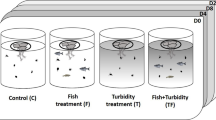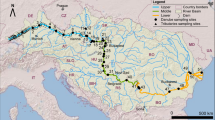Abstract
The role of phytoplankton as one of the main sources of energy entering the water food network is especially evident in fish-rearing ponds. Indeed, in these comparatively small ponds (unlike many lakes), variations in the abundance of phytoplankton can be extremely sensitive to the action of external factors, including human activity. Here, we present results of the analysis of the phytoplankton dynamics in adjacent fishponds and in supplying/recipient river courses upstream and downstream of the ponds during a growing season. In the grow-out ponds, phytoplankton biomass is shown to reach maximums in spring and in early autumn, while in the nursery pond, the phytoplankton dynamics is characterized by one long peak. The specificity of fish-rearing ponds as the human-regulated reservoirs clearly manifests itself under comparison of phytoplankton biomass of ponds with the biomass of phytoplankton inhabiting a nearby river. The averaged phytoplankton biomass in the ponds was 6.2–10.1 times higher than in the river. Besides, we show here that the taxonomic composition of phytoplankton in the river differs significantly from the composition of phytoplankton in the fish-rearing ponds. In particular, Cyanobacteria and Chlorophyta were revealed as the major portion of the phytoplankton in the fish-rearing ponds, while in the river their abundances were low.







Similar content being viewed by others
References
Affan A, Jewel AS, Haque M, Khan S, Lee J-B (2005) Seasonal cycle of phytoplankton in aquaculture ponds in Bangladesh. Algae 20:43–52. https://doi.org/10.4490/algae.2005.20.1.043
Aheyets V, Kostousov V, Banina S, Martsul O (2020) Belarus fishing industry: development prospects. Sci Innov 205:4–9 (In Russian)
Alexander R, Smith R (2006) Trends in the nutrient enrichment of U.S. rivers during the late 20th century and their relation to changes in probable stream trophic conditions. Limnol Oceanogr 51:639–654. https://doi.org/10.4319/lo.2006.51.1_part_2.0639
Anneville O, Ginot V, Druart J-C, Angeli N (2002) Long-term study (1974–1998) of seasonal changes in the phytoplankton in Lake Geneva: a multi-table approach. J Plankton Res 24:993–1007. https://doi.org/10.1093/plankt/24.10.993
Bilous O, Barinova S, Klochenko P (2014) The role of phytoplankton in the ecological assessment of the Southern Bug River middle reaches (Ukraine). Fundam Appl Limnol 4(4):277–295. https://doi.org/10.1127/1863-9135/2014/0509
Biro P (1995) Management of pond ecosystems and trophic webs. Aquaculture 129:373–386. https://doi.org/10.1016/0044-8486(94)00291-U
Bostock J, McAndrew B, Richards R, Jauncey K, Telfer T, Lorenzen K, Little D, Ross L, Handisyde N, Gatward I, Corner R (2010) Aquaculture: global status and trends. Phil Trans R Soc B Biol Sci 365:2897–2912. https://doi.org/10.1098/rstb.2010.0170
Cereghino R, Biggs J, Oertli B, Declerck S (2008) The ecology of European ponds: defining the characteristics of a neglected freshwater habitat. Hydrobiologia 597:1–6. https://doi.org/10.1007/s10750-007-9225-8
De Senerpont Domis LN, Elser JJ, Gsel AS, Huszar VLM, Ibelings BW, Jeppesen E, Kosten S, Mooij WM, Roland F, Sommer U, van Donk E, Winder M, Lurling M (2013) Plankton dynamics under different climatic conditions in space and time. Freshw Biol 58:463–482. https://doi.org/10.1111/fwb.12053
Dodds W (2006) Eutrophication and trophic state in rivers and streams. Limnol Oceanogr 51:671–680. https://doi.org/10.4319/lo.2006.51.1_part_2.0671
Dodson SI, Arnott SA, Cottingham KL (2000) The relationship in lake communities between primary productivity and species richness. Ecology 81:2662–2679. https://doi.org/10.1890/0012-9658(2000)081[2662:TRILCB]2.0.CO;2
Golovko GV (2008) Biological productivity of nondurable fishery ponds. Problems of Fisheries 9:754–763
Hillebrand H, Durselen C-D, Kirschtel D, Pollingher U, Zohary T (1999) Biovolume calculation for pelagic and benthic microalgae. J Phycol 35:403–424. https://doi.org/10.1046/j.1529-8817.1999.3520403.x
Kiselev IA (1969) Plankton of seas and continental water bodies. Nauka, Leningrad (In Russian)
Kitner M, Poulíčková A (2001) Seasonal dynamic of the phytoplankton in two fishponds near Protivanov (Moravia, the Czech Republic). Czech Phycology, Olomouc 1:45–51 (In Czech)
Konchits VV, Kostousov VG, Stolovich VN, Voronova GP, Skurat EK, Chutaeva AI, Tarazevich EV (2005) The system of fish industry of Belarus. Tonpic Press, Minsk (In Russian)
Mainstone CP, Parr W (2002) Phosphorus in rivers-ecology and management. Sci Total Environ 282–283:25–47. https://doi.org/10.1016/S0048-9697(01)00937-8
Mikheeva TM (1999) Algaeflora of Belarus. Publishing House, Minsk (Taxonomic catalogue)
Mikheyeva TM (1989) Methods of quantitative enumeration of the nanophytoplankton (review). Hydrobiol J 25:3–21
Napiórkowska-Krzebietke A, Hutorowicz A, Tucholski S (2011) Dynamics and structure of phytoplankton in fishponds fed with treated wastewater. Pol J Environ Stud 20:157–166
Pashkou GP, Kalenda LV, Zhukouskaya TI, Lopuh PS, Pirozhnik II, Ulasou BP, Yakushka VP (2007) Blue treasure of Belarus. Belaruskaya Entsyclopediya, Minsk (In Belorussian)
Peretyatko A, Teissier S, De Backer S, Triest L (2012) Biomanipulation of hypereutrophic ponds: when it works and why it fails. Environ Monit Assess 184:1517–1531. https://doi.org/10.1007/s10661-011-2057-z
Prosyanik LV (1974) The production of pond phytoplankton and its regulation. Probl Fish Ind Belarus 10:36–41 (In Russian)
R Core Team (2020) R: A language and environment for statistical computing. R foundation for statistical computing, Vienna, Austria. https://www.R-project.org/. Accessed 22 Oct 2020
Rahman MM, Verdegem M, Nagelkerke L, Wahab MA, Milstein A, Verreth J (2008) Effects of common carp Cyprinus carpio (L.) and feed addition in rohu Labeo rohita (Hamilton) ponds on nutrient partitioning among fish, plankton and benthos. Aquac Res 39:85–95. https://doi.org/10.1111/j.1365-2109.2007.01877.x
Reynolds CS (1989) Physical determinants of phytoplankton succession. In: Sommer U (ed) Plankton ecology. Succession in plankton communities. Springer-Verlag, Berlin, pp 9–56
Rojo C, Ortega-Mayagoitia E, Rodrigo MA, Alvarez-Cobelas M (2000) Phytoplankton structure and dynamics in a semiarid wetland, the National Park “Las Tablas de Daimiel” (Spain). Arch Hydrobiol 148:397–419. https://doi.org/10.1127/archiv-hydrobiol/148/2000/397
Semenov AD (ed) (1977). Gidrometeoizdat, Leningrad (In Russian)
Sen B, Sonmez F (2006) A study on the algae in fish ponds and their seasonal variations. Int J Sci Technol 1:25–33
Sennikova VD, Konchits VV, Chutaeva AI, Dokuchaeva SM, Fedorova VG, Dashkevich VS (2002) Seasonal development of phytoplankton of experimental growth ponds. Probl Fish Ind Belarus 18:148–155 (In Russian)
Smith VH, Joye SB, Howarth RW (2006) Eutrophication of freshwater and marine ecosystems. Limnol Oceanogr 51:351–355. https://doi.org/10.4319/lo.2006.51.1_part_2.0351
Sommer U, Gliwicz ZM, Lampert W, Duncan A (1986) The PEG-model of seasonal succession of planktonic events in fresh waters. Arch Hydrobiol 106:433–471
Søndergaard M, Jeppesen E, Jensen JP (2005) Pond or lake: does it make any difference? Arch Hydrobiol 162:143–165. https://doi.org/10.1127/0003-9136/2005/0162-0143
Tavares LHS, Millan RN, Santeiro RM (2010) Characterization of a plankton community in a fish farm. Acta Limnol Bras 22:60–69. https://doi.org/10.4322/actalb.02201008
Turcios AE, Papenbrock J (2014) Sustainable treatment of aquaculture effluents—what can we learn from the past for the future? Sustainability 6:836–856. https://doi.org/10.3390/su6020836
Varga M, Berzi-Nagy L, Csukas B, Gyalog G (2020) Long-term dynamic simulation of environmental impacts on ecosystem-based pond aquaculture. Environ Model Soft 134:104755. https://doi.org/10.1016/j.envsoft.2020.104755
Wetzel RG, Likens GE (2000) Limnological analysis, 3rd edn. Springer-Verlag, New York
Winberg GG, Lyakhnovich VP (1965) The fertilization of ponds. Food Industry, Moscow (In Russian)
Wirasith C, Traichaiyaporn S, Waraegsiri B, Chen J (2011) Water quality and algae succession in integrated fish ponds. J Agric Technol 7:1633–1645
Yang X, Wu X, Hao H-l, He Z-l (2008) Mechanisms and assessment of water eutrophication. J Zheijang Univ Sci B Biomed Biotechnol 9:197–209. https://doi.org/10.1631/jzus.B0710626
Zhuravlev YN (1994) Some aspects of optimization of development of phytoplankton of fish industries water bodies. GosNIORH, St. Petersburg. (In Russian)
Acknowledgements
We are very thankful to the staff of the Republican Unitary Enterprise «Fish Industry Institute» for the provided assistance in field sampling.
Funding
This study was partially supported by the Belarusian Republican Foundation for Fundamental Research and State Task of Belarus (GPNI GR no. 20212317). MBV carried out this work within the framework of State Task no. 075-00381-21-00.
Author information
Authors and Affiliations
Contributions
Conceptualization, formal analysis, investigation, preparing original draft, ABV. Writing, review and editing, ABV and MBV. The authors have read and agreed to the final version of the manuscript.
Corresponding author
Ethics declarations
Conflict of interest
The authors declare no conflict of interest.
Ethical approval and consent to participate
This article does not contain any studies with human participants or animals performed by any of the authors.
Consent for publication
All authors have read and agreed to the final version of the manuscript.
Additional information
Publisher's Note
Springer Nature remains neutral with regard to jurisdictional claims in published maps and institutional affiliations.
Rights and permissions
Springer Nature or its licensor (e.g. a society or other partner) holds exclusive rights to this article under a publishing agreement with the author(s) or other rightsholder(s); author self-archiving of the accepted manuscript version of this article is solely governed by the terms of such publishing agreement and applicable law.
About this article
Cite this article
Adamovich, B.V., Medvinsky, A.B. Human activity as a factor causing the biomass, structure and seasonal dynamics of phytoplankton in adjacent fishponds. Rend. Fis. Acc. Lincei 34, 605–633 (2023). https://doi.org/10.1007/s12210-023-01158-0
Received:
Accepted:
Published:
Issue Date:
DOI: https://doi.org/10.1007/s12210-023-01158-0




